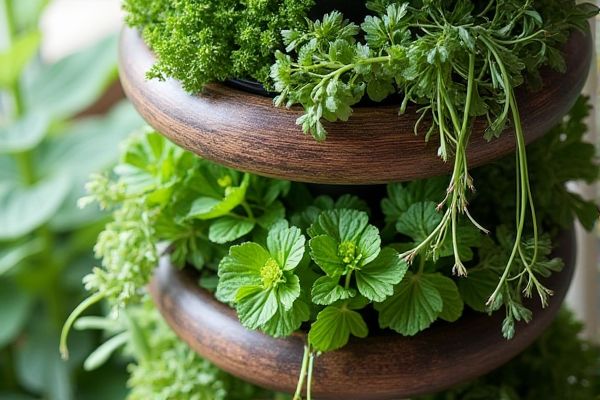
Herb spirals maximize space by creating a tiered garden that supports different plant microclimates, while vertical herb towers focus on growing herbs upward, saving ground area and making harvesting easier. Discover which structure best suits your gardening style and space requirements by exploring the rest of the article.
Table of Comparison
| Feature | Herb Spiral | Vertical Herb Tower |
|---|---|---|
| Design | Spiral mound design with varied microclimates | Stacked vertical planter with multiple levels |
| Space Efficiency | Moderate; uses horizontal and vertical space | High; maximizes vertical space |
| Water Drainage | Gravity-fed; water trickles down spiral | Often uses self-watering systems or drip irrigation |
| Plant Variety | Supports diverse herbs with different sunlight needs | Good for compact herb collections |
| Installation | Requires soil mound construction and space | Modular assembly, often portable |
| Maintenance | Moderate; needs occasional reshaping and watering | Low to moderate; easy access to plants |
| Ideal Use | Garden settings with moderate space | Small yards, balconies, and urban gardening |
Introduction to Herb Spiral and Vertical Herb Tower
Herb spirals and vertical herb towers are innovative gardening structures designed to maximize space and promote healthy herb growth. An herb spiral is a spiral-shaped mound creating diverse microclimates for varying plant needs, while a vertical herb tower stacks planting pockets vertically for high-density cultivation. Both methods optimize sunlight exposure, air circulation, and irrigation efficiency in limited spaces.
Key Design Differences
Herb spirals feature a circular, sloped design that maximizes space by creating microclimates through varied elevation levels, ideal for growing diverse herbs with different sunlight and moisture needs. Vertical herb towers use stacked layers or pockets to grow herbs upward, optimizing limited horizontal space and enhancing accessibility for harvesting in compact areas. The spiral emphasizes natural water drainage and easy maintenance, while the vertical tower prioritizes space-saving and modular expansion options.
Space Efficiency Comparison
Herb spirals utilize vertical and horizontal space by stacking plants in a spiral mound, maximizing sunlight and water efficiency within a compact footprint, ideal for small gardens. Vertical herb towers optimize space by growing herbs in stacked layers up to several feet high, significantly increasing planting density on minimal ground area. While herb spirals blend landscaping and functionality, vertical towers excel in ultra-compact urban settings where floor space is extremely limited.
Plant Diversity and Compatibility
Herb spirals offer diverse microclimates that support a wider variety of plants with different water and sunlight needs, enhancing plant compatibility. Vertical herb towers maximize space vertically, ideal for small gardens but typically support fewer plant species due to limited root zones. Your choice depends on the balance between plant diversity and available growing space for optimal herb cultivation.
Watering and Drainage Requirements
Herb spirals require careful attention to watering patterns due to their tiered design, which allows water to flow from top to bottom, necessitating well-draining soil at lower levels to prevent waterlogging. Vertical herb towers often feature integrated drainage systems and wick irrigation, enabling consistent moisture distribution while minimizing water waste. Both structures benefit from soil mixes rich in organic matter to retain moisture yet facilitate proper drainage, optimizing herb growth and health.
Sunlight Exposure and Placement
A herb spiral maximizes sunlight exposure by allowing different herbs to thrive in microclimates created by its stacked, tiered design, ideal for diverse sun and shade needs all in one spot. Vertical herb towers conserve space and often require placement where they can receive consistent, direct sunlight on all sides, making them perfect for small balconies or patios. Your choice depends on the available sunlight patterns and the specific light requirements of your herbs to ensure optimal growth.
Maintenance and Accessibility
A herb spiral requires regular maintenance due to its tiered structure, ensuring each level receives proper watering and pruning to promote healthy growth. Vertical herb towers offer enhanced accessibility, allowing You to harvest herbs at eye level or waist height, reducing the need to bend or stretch. Both methods demand consistent care, but vertical towers simplify reach and maintenance in compact spaces.
Material and Construction Costs
Herb spirals typically require natural materials such as stones, bricks, or timber, resulting in moderate construction costs influenced by the availability and quality of these materials. Vertical herb towers often utilize lightweight, durable materials like recycled plastics or metals, which can elevate the initial investment but offer long-term cost efficiency through durability and space-saving design. Budget considerations depend on the scale, material sourcing, and installation complexity unique to each structure type.
Aesthetic Appeal and Garden Integration
Herb spirals create a natural, tiered landscape that harmonizes seamlessly with traditional garden designs through their organic, flowing curves, while vertical herb towers offer a modern, space-saving aesthetic ideal for urban gardens and small patios. Your choice depends on whether you prioritize the artistic, layered visual impact of spirals or the sleek, compact structure of vertical towers for efficient garden integration. Both options enhance garden aesthetics but cater to different spatial and stylistic needs.
Choosing the Best Option for Your Garden
Herb spirals create a microclimate that optimizes growing conditions by varying moisture and sunlight levels, ideal for diverse herb varieties in compact spaces. Vertical herb towers maximize vertical space and improve accessibility, suitable for small gardens or urban environments with limited ground area. Selecting the best option depends on available space, desired plant diversity, and maintenance preferences, ensuring efficient growth and easy harvesting.
 homyna.com
homyna.com